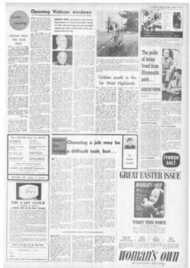Page 5, 8th April 1966
Page 5

Report an error
Noticed an error on this page?If you've noticed an error in this article please click here to report it.
Tags
Share
Related articles
Pope John Xxiii Tops Herald Poll
Pius Ix And John Xxiii Belong Together
Letters From Vatican City
John Paul Ii To Beatify The Popes Of The Great Councils
Pope John's Un1 Versal Love
Opening Vatican windows
THE characters and policies of Pius XII and John XXIII, and the contribution that each made to the gradual aggiornamento of the Church and the new awareness of the heeds of the present age, is the subject of an important new book.
In The Church on the Move, which comes out next Thursday, Fr. W. A. Purdy studies the most acute politicoreligious and sociological problems of our day, and traces the development of the ecumenical movement, of the role of the bishops, and of the importance attached to biblical studies (Hollis & Carter, 30s.).
In connection with biblical studies, it is interesting to note that the author considers the
encyclical Divino A Wattle Spiritu, issued by Pius XII in 1943, to be "probably the greatest single achievement of Pope Pius XII's reign, and one of his assured titles to a place in history".
His account of the politicoreligious situation in modern Italy i6 of absorbing interest to anyone who, like myself. lived for many years under the Fascist regime. The peculiarly cramped conditions of Catholic life and activity under the "Non eXpedi1" rule, and later on under the Fascist dictatorship, were, he believes, largely responsible for the obstinate persistence of a defensive "integralism" in the Church, from the Vatican downwards.
Generally speaking, Italian Catholics, like the Catholics in Germany, feared three things above all else: Liberalism, Freemasonry and Bolshevism.
They were also afraid to loosen their tight hold on the hag containing the deposilum fidei, as if the contents were like "squirrels in a sack, likely to escape at a moment's relaxation of vigilance".
The cautious paternalistic attitude of the Cardinals had been a source of irritation to the more liberal-minded since the time of Leo XIII, who was the first to throw open the Vatican archives.
He once caustically observed to Cardinal Gasquet, the English Benedictine historian. that "if the four Evangelists had been writing today they would have found the denial of Peter and the betrayal of Judas being blue-pencilled for fear of offending the dignity of the Apostolic College".
The period covered by this book is extensive, not so much in its span of years as in the development and diversity of the scene and the events.
The opening sentence of the Prologue is a brilliant touch. reminding the reader of the milieu in which Pius XII had begun his career as a Papal diplomat: "On May 28, 1917. a gilt baroque coach drove Eugenio Pacelli . . . through the streets of Munich to the Court of Ludwig of Bavaria. to present his credentials as Vatican envoy."
The differences of temperament and style between Pius XII and John XXIII are studied with careful objectivity and scrupulous fairness. It is apparent that much preparatory work for the Vatican Council had been done by Pope John's predecessor, but it is also very clear that only Pope John, with his singular gifts of simplicity and understanding, could have received the inspiration for such a daring project.
An interesting point made by the author is that whereas Pius XII had grown up in a strongly clerical and paternalistic environment, Pope John had served for many years in lands where the clergy had "to take a back seat, as a minority among the Orthodox in Bulgaria; in lay dress and obscurity in Istanbul; dealing with an anti-clerical political tradition in France".
In fact it is easy to find in the Nuncio's diplomatic ad
dresses in Paris, especially in
those to Unesco, and above all in his great encyclicals, a sincere admiration for the work of lay bodies "of good will" and, says Fr. Purdy, "when he addresses himself to 'all men of good will' he had already created for himself a vast audience exactly so describable".
He was not afraid of what he called "socialisation", which he said, in Mater and MagisIra, "within the framework of the moral order. is not of its nature dangerous or detrimental to the individual. On the contrary, it will in all likelihood help him to develop and perfect his own personal talent."
Fr. Purdy does not flinch from a close examination of the vexed question of Pius XII and the Jewish victims of Nazism,
and sums it up in the words of
Cardinal Doepfner: "The retrospective judgment of history perfectly authorises the opinion that Pius XII should have protested more firmly. There is nevertheless no justification for doubting the sincerity of his motives or the authenticity of his profound reasons."
It is interesting to turn from this study of the policies of Pius XII and John XXIII to The Priest, a collection of sermons, addresses and pastoral letters given by Cardinal Montint when he was in Milan from 1957 to 1963 (Helicon, 25s.).
Cardinal Montini (now Pope Paul) was the first Italian cardinal to welcome the announcement of the Council. which he hailed as "a historic event of immense grandeur". In his addresses and pastoral letters he tried to set the Council in its historical setting and to explain its purposes.
"You must remember that you have received the sub-diaconate. the diaconate. the priesthood. during the time of the Council." he told his new priests. "In so doing you will realise that the history of the Church is your history" . , . "The Council reaches out to a new relationship with humanity "
blog comments powered by Disqus

















